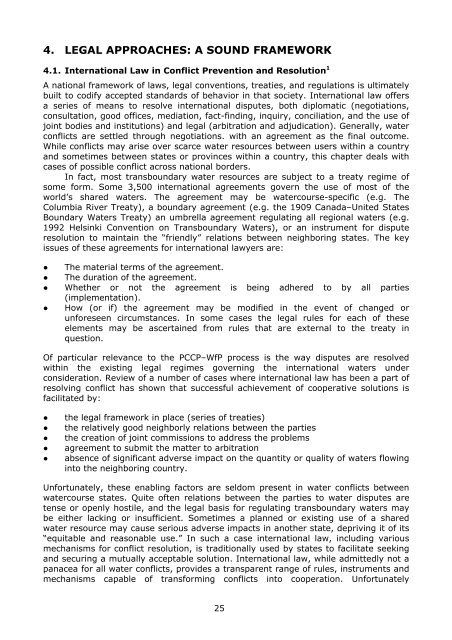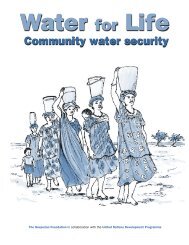Water security and peace: a synthesis of studies ... - unesdoc - Unesco
Water security and peace: a synthesis of studies ... - unesdoc - Unesco
Water security and peace: a synthesis of studies ... - unesdoc - Unesco
Create successful ePaper yourself
Turn your PDF publications into a flip-book with our unique Google optimized e-Paper software.
4. LEGAL APPROACHES: A SOUND FRAMEWORK<br />
4.1. International Law in Conflict Prevention <strong>and</strong> Resolution 1<br />
A national framework <strong>of</strong> laws, legal conventions, treaties, <strong>and</strong> regulations is ultimately<br />
built to codify accepted st<strong>and</strong>ards <strong>of</strong> behavior in that society. International law <strong>of</strong>fers<br />
a series <strong>of</strong> means to resolve international disputes, both diplomatic (negotiations,<br />
consultation, good <strong>of</strong>fices, mediation, fact-finding, inquiry, conciliation, <strong>and</strong> the use <strong>of</strong><br />
joint bodies <strong>and</strong> institutions) <strong>and</strong> legal (arbitration <strong>and</strong> adjudication). Generally, water<br />
conflicts are settled through negotiations. with an agreement as the final outcome.<br />
While conflicts may arise over scarce water resources between users within a country<br />
<strong>and</strong> sometimes between states or provinces within a country, this chapter deals with<br />
cases <strong>of</strong> possible conflict across national borders.<br />
In fact, most transboundary water resources are subject to a treaty regime <strong>of</strong><br />
some form. Some 3,500 international agreements govern the use <strong>of</strong> most <strong>of</strong> the<br />
world’s shared waters. The agreement may be watercourse-specific (e.g. The<br />
Columbia River Treaty), a boundary agreement (e.g. the 1909 Canada–United States<br />
Boundary <strong>Water</strong>s Treaty) an umbrella agreement regulating all regional waters (e.g.<br />
1992 Helsinki Convention on Transboundary <strong>Water</strong>s), or an instrument for dispute<br />
resolution to maintain the “friendly” relations between neighboring states. The key<br />
issues <strong>of</strong> these agreements for international lawyers are:<br />
! The material terms <strong>of</strong> the agreement.<br />
! The duration <strong>of</strong> the agreement.<br />
! Whether or not the agreement is being adhered to by all parties<br />
(implementation).<br />
! How (or if) the agreement may be modified in the event <strong>of</strong> changed or<br />
unforeseen circumstances. In some cases the legal rules for each <strong>of</strong> these<br />
elements may be ascertained from rules that are external to the treaty in<br />
question.<br />
Of particular relevance to the PCCP–WfP process is the way disputes are resolved<br />
within the existing legal regimes governing the international waters under<br />
consideration. Review <strong>of</strong> a number <strong>of</strong> cases where international law has been a part <strong>of</strong><br />
resolving conflict has shown that successful achievement <strong>of</strong> cooperative solutions is<br />
facilitated by:<br />
! the legal framework in place (series <strong>of</strong> treaties)<br />
! the relatively good neighborly relations between the parties<br />
! the creation <strong>of</strong> joint commissions to address the problems<br />
! agreement to submit the matter to arbitration<br />
! absence <strong>of</strong> significant adverse impact on the quantity or quality <strong>of</strong> waters flowing<br />
into the neighboring country.<br />
Unfortunately, these enabling factors are seldom present in water conflicts between<br />
watercourse states. Quite <strong>of</strong>ten relations between the parties to water disputes are<br />
tense or openly hostile, <strong>and</strong> the legal basis for regulating transboundary waters may<br />
be either lacking or insufficient. Sometimes a planned or existing use <strong>of</strong> a shared<br />
water resource may cause serious adverse impacts in another state, depriving it <strong>of</strong> its<br />
“equitable <strong>and</strong> reasonable use.” In such a case international law, including various<br />
mechanisms for conflict resolution, is traditionally used by states to facilitate seeking<br />
<strong>and</strong> securing a mutually acceptable solution. International law, while admittedly not a<br />
panacea for all water conflicts, provides a transparent range <strong>of</strong> rules, instruments <strong>and</strong><br />
mechanisms capable <strong>of</strong> transforming conflicts into cooperation. Unfortunately<br />
25
















